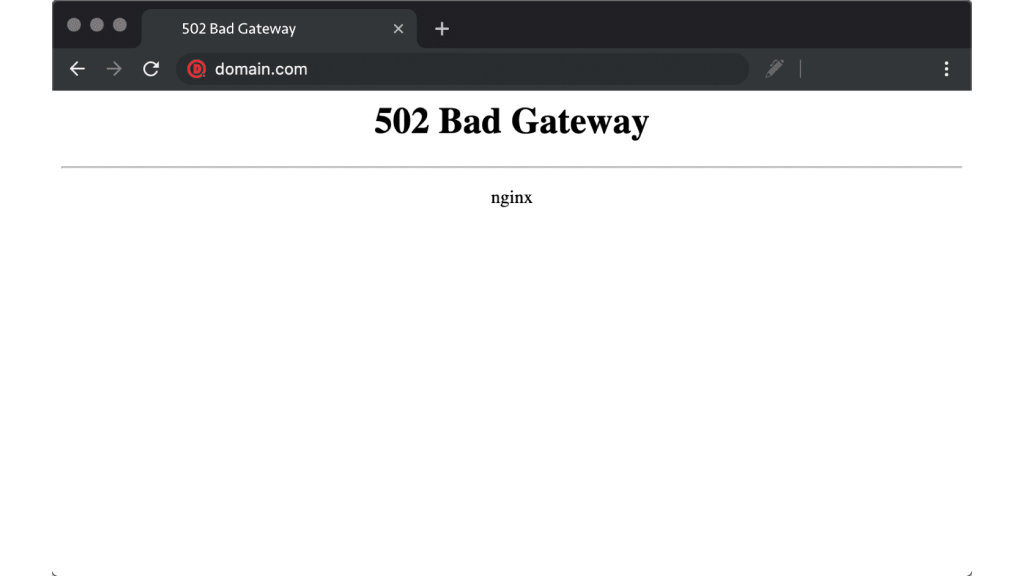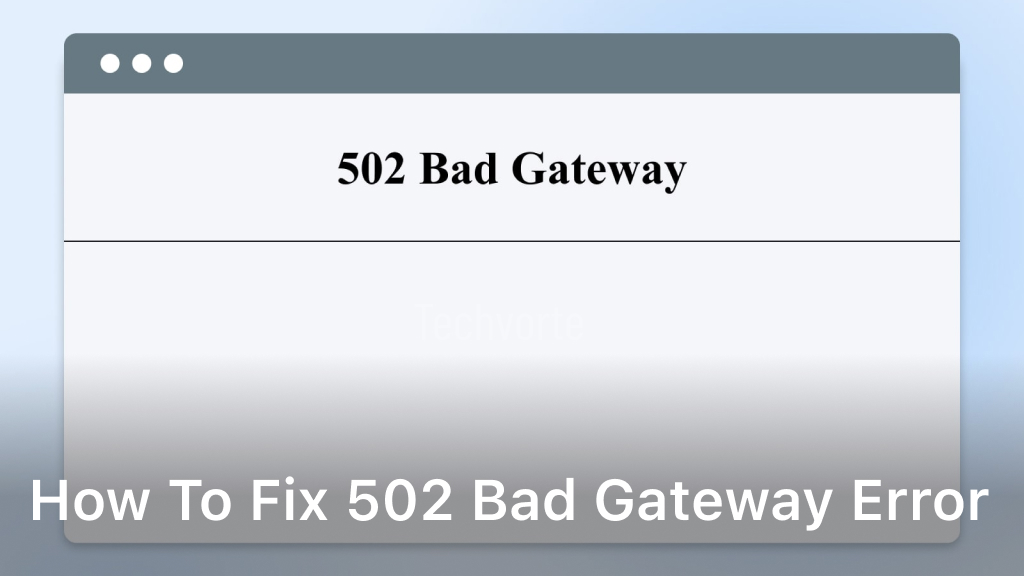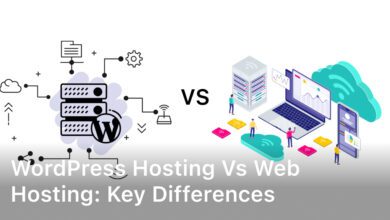You’ve probably seen the “502 Bad Gateway” error while surfing the web.
It shows up when servers can’t talk to each other well.
This issue hurts your experience as a user and can be bad for website owners too.
It’s a common headache for both sides.
But what’s behind this error? It often comes from problems with proxy servers, the backend server or the network.
A proxy server can’t hand over the right message to the website’s server, so you see the 502 error.
It means the site couldn’t fully respond, even though the proxy server was fine.
In this article, we want to dig deep into the 502 bad gateway error.
We’ll look at what makes it happen and how to lower the chances of seeing it.
Knowing what causes it and fixing those issues can make your site work better.
Let’s uncover the secrets of the 502 error and learn how to beat it.
Understanding the 502 Bad Gateway Error
When you see a 502 bad gateway error, it’s key to know what’s happening.
This error happens when a server acting as a gateway or proxy gets a bad message from another server.
We’ll look at what this error means and why it happens.
Definition and Meaning
A 502 bad gateway error shows there’s a problem on the server’s side.
It means the server acting as a gateway or proxy got a bad message from another server.
It’s not the fault of your internet or browser.
Imagine you ask a website for something. Your request goes to a gateway server first.
This server then tries to talk to the real server that can help you.
If the real server doesn’t answer correctly, you’ll see a 502 error.
Common Scenarios Triggering the Error
A 502 error can happen for many reasons. Network issues between servers are one big cause.
If they can’t talk to each other right, you get a 502 error.
If the main server has too much to do, it might not respond well.
This can be when lots of people are trying to use the site. Or, if the server is not strong enough.
Bad setup of servers that share the work (load balancers) can also be a problem.
They are meant to help but sometimes they send requests to servers that are broken. Then you would see a 502 error.
Problems with how proxy servers are set up can also cause a 502 error.
Proxy servers help clients and other servers talk. If something is wrong with a proxy server, it can’t do its job right.
Causes of 502 Bad Gateway Errors

502 Bad Gateway errors can pop up for many reasons.
It could be because the proxy server is set up wrong. Or the backend server might not be working right.
Even network problems can cause this issue. We’ll dive deeper into each of these issues.
Proxy Server Issues
Proxy servers help route requests to the proper place.
But if they’re set up wrong or have bad firewall rules, you might see a 502 error.
Things like wrong routes or firewall rules that clash can stop the proxy server from connecting. This leads to the error showing up.
Backend Server Failure
If the backend server fails, this can also trigger a 502. The backend server might crash, get too many requests or face app problems.
These issues can be from hardware, software bugs or using up all the resources.
When the proxy server gets a bad reply from the backend, a 502 error appears.
Network Connectivity Problems
502 errors can also stem from network issues. Problems like timeouts, bad routes, or network traffic jams can mess with the communication between servers.
CDN caching problems or DNS mix-ups make it hard for the proxy server to talk to the backend server. This leads to the error.
To fix 502 errors, it’s important to find out what’s really wrong.
Check the proxy server’s setup, the backend server’s side and the network’s health.
By doing this, site owners can locate the problem’s source and fix it right.
Don’t forget, keeping things well maintained, configuring correctly and watching closely can prevent these errors.
It ensures everyone has a smooth time on the site.
Impact on User Experience and Website Performance
Seeing a 502 Bad Gateway error can make users very frustrated.
The error doesn’t explain what’s wrong, so users are left confused.
Often, they just leave the site, which can increase the bounce rate.
This error also makes the website unavailable for a longer time.
It not only looks bad to users but also to search engines. Search engines like sites that work well all the time.
A website with many 502 errors might not seem trustworthy, so it could rank lower in search results.
502 Bad Gateway errors don’t just cause technical issues, they can also hurt a brand.
Today, people expect websites to work perfectly.
When they don’t, users might think the brand is unreliable or unprofessional. This can damage the brand’s image greatly.
To keep users happy and protect the brand, website owners need to fix 502 errors fast.
They should find and solve the problem causing the error.
This helps to keep the site running smoothly and avoid harming the brand’s reputation or search rankings.
Troubleshooting and Resolving 502 Bad Gateway Errors
When you see a 502 Bad Gateway error, you must work step by step to fix it.
Start by looking closely at the problem. Then, figure out exactly what’s causing the error.
Identifying the Source of the Problem
The first thing to do is see if the issue is with the proxy server, the backend server or the network.
Look at the server logs and error messages for clues. Talk with your server team or hosting provider to check the server setup for any issues.
Server-Side Fixes
After finding the problem, work on solutions from the server side.
Update server software and adjust server settings. Also, check the application code for any problems and fix them.
Client-Side Workarounds
While fixing things on the server, there are also things users can do to help.
Suggest they clear their browser cache and cookies.
Also, guide them in adjusting their proxy settings or turning off VPNs if needed. These steps can lessen the effect of the error for users.
Following a clear process can help fix 502 errors and keep your site running smoothly.
Regular server checks and quick adjustments to your applications are important.
They can reduce how often these errors happen and keep your visitors happy.
Preventing Future Occurrences
Fixing 502 Bad Gateway errors is important, but stopping them before they happen is even better. Website owners should follow best practices.
Also, they need to boost their server’s performance to lower the chance of these errors. Doing so ensures users enjoy a smooth experience.
Regular Server Maintenance
Keeping your server maintained is key to avoiding problems.
This means updating software, adjusting server settings and having enough power for your website’s traffic.
With regular checks, you can spot and fix issues early, preventing 502 errors.
Load Balancing and Scalability
For a more dependable website and to avoid server overload, using load balancing and scalable designs is essential. Load balancing shares traffic across servers.
This stops any single server from getting too much traffic. With scalable setups, websites can manage traffic changes without performance dips.
Monitoring and Alerting Systems
Early detection through monitoring and alerts can save your website’s day.
With the right tools, you can watch the health of your servers, network and applications.
These tools alert you in real-time to any issues. This fast feedback means quick fixes, cutting down on 502 errors for your visitors.
FAQ
What is a 502 Bad Gateway error?
A 502 Bad Gateway error points to a snag in internet server connections. It happens when a gateway or proxy server gets an incorrect message from another server.
What causes 502 Bad Gateway errors?
502 Bad Gateway errors happen due to many issues. These include problems in proxy servers, firewalls, server failures, and even network issues. Application faults and CDN cache problems are also common causes.
How do 502 Bad Gateway errors impact user experience and website performance?
When users face 502 Bad Gateway errors, they can get frustrated and leave the site. This leads to a higher bounce rate and hurts a website’s performance and SEO. It also damages the site’s reputation.
Solving these errors quickly is key to keeping users happy. It avoids the related issues with website operation and user experience.
How can I troubleshoot and resolve 502 Bad Gateway errors?
Tackling 502 Bad Gateway errors means finding where the problem is. It could be the proxy, server, or the network itself. Fixing servers, improving configurations, and adjusting client settings like proxy and cache help.
What can I do to prevent future occurrences of 502 Bad Gateway errors?
To avoid 502 errors, keep servers well-maintained and resources plenty. Balance loads and set up monitoring. This helps catch potential errors early and keep the site running smoothly.
Are 502 Bad Gateway errors always caused by server-side issues?
502 Bad Gateway errors often show server problems. Yet, client side issues like network or browser settings can also trigger them. A full check of both sides aids in finding and fixing the error.
Can CDN caching contribute to 502 Bad Gateway errors?
CDNs sometimes cause 502 errors if they face trouble with their origin server or caching process. In these cases, they may deliver a 502 error to the user.
How can I monitor my website for 502 Bad Gateway errors?
Using monitoring tools and alert systems is a proactive way to handle 502 errors. They keep an eye on your site’s health, alert about issues, and provide data for bettering the site’s performance.





